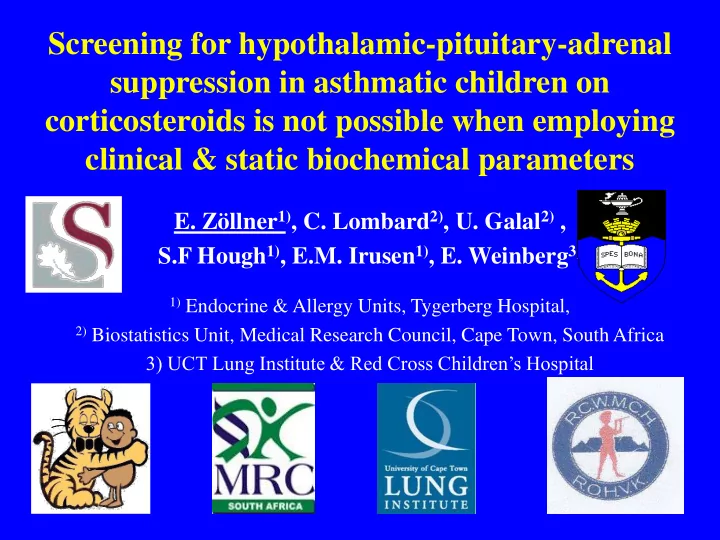

Screening for hypothalamic-pituitary-adrenal suppression in asthmatic children on corticosteroids is not possible when employing clinical & static biochemical parameters E. Zöllner 1) , C. Lombard 2) , U. Galal 2) , S.F Hough 1) , E.M. Irusen 1) , E. Weinberg 3) 1) Endocrine & Allergy Units, Tygerberg Hospital, 2) Biostatistics Unit, Medical Research Council, Cape Town, South Africa 3) UCT Lung Institute & Red Cross Children’s Hospital
Background • Up to 2/3 of all asthmatic children on corticosteroid (CS) therapy were found to have a degree of hypothalamic pituitary adrenal axis suppression (HPAS). • HPAS may not be recognised until the child presents with an adrenal crisis or non-specific symptoms. • Only dynamic testing will identify which children are at risk of adrenal crisis, but this is impractical. • A screening test should thus be identified.
Objective To determine which clinical/biochemical parameter is the most useful screening test for HPAS in asthmatic children .
Methods • 143 asthmatic children, 5-18 years old, on inhaled corticosteroids (ICS), with/without additional CS therapy, were recruited from the allergy units of Tygerberg & Red Cross Children’s Hospitals and the UCT Lung Institute. • Height, weight, height velocity (HV), weight velocity (WV), change in systolic BP from recumbent to standing ( Δ SBP) were recorded. • Early morning urine (06:00-07:00h) for urinary free cortisol (UFC) was collected. • Morning serum (08:00-09:00h) cortisol (C), ACTH & dehydroepiandrosterone sulphate (DHEAS) was obtained. • Overnight metyrapone (MTP) test was performed if C > 83nmol/l.
Table 1: Spearman correlations between PMTP ACTH, 11 DOC, 11DOC+C and screening variables ACTH 11DOC 11DOC+C r P r P Screening Variable r P Height SDS 0.12 0.186 -0.13 0.120 -0.05 0.542 0.10 0.262 -0.01 0.195 -0.10 0.279 Weight SDS HV SDS 0 0.999 0.07 0.420 0.07 0.452 WV SDS -0.04 0.638 0.07 0.421 0.09 0.302 Δ SBP 0 0.992 0.05 0.538 -0.04 0.616 C 0.05 0.538 0.08 0.374 0.12 0.176 ACTH 0.10 0.248 0.04 0.640 0.10 0.263 DHEAS 0.20 0.025 0.21 0.017 0 0.995 UFC (nmol/m 2 ) 0.08 0.379 0.19 0.033 0.20 0.022 UFC (nmol/mmolCr) 0.08 0.397 0.14 0.111 0.16 0.064
Table 2: HPAS* by age group and gender Age (years) Category 5-9 10-14 15-18 Total Males No HPAS 18 32 9 59 HPAS 2 6 2 10 Total 20 38 11 69 Females No HPAS 14 25 9 48 HPAS 6 3 1 10 Total 20 28 10 58 Total No HPAS 32 57 18 107 HPAS 8 9 3 20 127 § Total 40 66 21 * PMTP ACTH<106pg/ml AND 11DOC<208nmol/l AND 11DOC+C<400nmol/l § Number of patients who had DHEAS levels measured
Fig. 1: Predicted ROC curves of DHEAS versus HPAS* by age from a ROC regression model. 1 .75 .5 .25 0 0 .25 .5 .75 1 1-Specificity DHEAS 5-9 years 10-14 years 15-18 years
Fig. 2: ROC curve of DHEAS versus HPAS for 5-9 yr age group 1.00 0.75 0.50 0.25 0.00 0.00 0.25 0.50 0.75 1.00 1 - Specificity Area under ROC curve = 0.6935 (0.4716-0.9155)
Table 3: Diagnostic performance of DHEAS at 0.2 µmol/l for 5-9 year old age group Index of test validity Value 95% Confidence interval Sensitivity 0.87 0.47-1.00 Specificity 0.61 0.42-0.78 Positive predictive value 0.37 0.16-0.62 Negative predictive value 0.95 0.75-1.00 Accuracy 0.58 0.55-0.81 Positive likelihood ratio 2.26 1.35-3.78 Negative likelihood ratio 0.20 0.03-1.30
Conclusions & Recommendations • No clinical or static biochemical parameter is useful as a universal screening test for HPAS in asthmatic children. • DHEAS may be useful to rule out HPAS in children prior to adrenarche. • Basal adrenal function tests are not suitable for research studies. • The utility of DHEAS as a screening tool needs to be confirmed in a larger study.
Acknowledgements Financial support: Medical Research Council University of Stellenbosch SA Thoracic Society Harry Crossley Foundation Red Cross Children’s Hospital Recruitment: Sisters Hill, Poggenpoel, Pontac, Steyn, All paediatricians & MOs Lab support: GSH & TBH NHLS, BARC, Roche, B. Fenemore
Disclosure Statement The authors have nothing to declare.
Assays • Serum total C & UFC were measured with the ADVIA Centaur automated chemiluminescent assay. • 11-desoxycortisol (11DOC) levels were established by a competitive RIA (Biosource). • ACTH was measured by an automated sequential immunometric assay (Immulite 2000). • DHEAS levels were determined by an electrochemiluminescence immunoassay (Modular Analytics E170).
Statistical Analysis • Spearman correlations (r) between the post-metyrapone (PMTP) ACTH, 11DOC, 11DOC+C and each screening variable were determined. • A ROC regression model for DHEAS was used to look at association of age & sex. • A receiver operating characteristics (ROC) curve was drawn for the most promising test. • Diagnostic statistics and their 95% confidence intervals were calculated.
Recommend
More recommend